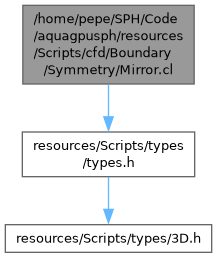Mirroring process for the symmetry boundary condition. More...
#include "resources/Scripts/types/types.h"
Include dependency graph for Mirror.cl:

Functions | |
| __kernel void | drop (__global int *imove, __global vec *r, unsigned int N, vec symmetry_r, vec symmetry_n, vec domain_max) |
| Remove the particles at the other side of the mirror. | |
| __kernel void | detect (const __global int *imove, const __global vec *r_in, __global unsigned int *imirror, unsigned int N, vec symmetry_r, vec symmetry_n) |
| Detect the particles to be mirrored. | |
| vec_xyz | reflection (vec_xyz u, vec_xyz n) |
| __kernel void | feed (__global int *imove, __global int *iset, __global unsigned int *imirror, __global unsigned int *imirror_invperm, __global float *m, __global vec *normal, __global vec *tangent, __global vec *r_in, __global vec *u_in, __global vec *dudt_in, __global float *rho_in, __global float *drhodt_in, unsigned int N, unsigned int nbuffer, vec symmetry_r, vec symmetry_n) |
| Mirror the particles marked with a flag imirror = 1. | |
Detailed Description
Mirroring process for the symmetry boundary condition.
Function Documentation
◆ detect()
| __kernel void detect | ( | const __global int * | imove, |
| const __global vec * | r_in, | ||
| __global unsigned int * | imirror, | ||
| unsigned int | N, | ||
| vec | symmetry_r, | ||
| vec | symmetry_n | ||
| ) |
Detect the particles to be mirrored.
The mirroring particles (the ones close enough to the symmetry plane) will be marked with imirror = 1.
- Parameters
-
imove Moving flags. - imove > 0 for regular fluid particles.
- imove = 0 for sensors.
- imove < 0 for boundary elements/particles.
r_in Position \( \mathbf{r} \). imirror 0 if the particle has not been mirrored, 1 otherwise. N Number of particles. symmetry_r Position of the symmetry plane. symmetry_n Normal of the symmetry plane. It is assumed as normalized.
◆ drop()
| __kernel void drop | ( | __global int * | imove, |
| __global vec * | r, | ||
| unsigned int | N, | ||
| vec | symmetry_r, | ||
| vec | symmetry_n, | ||
| vec | domain_max | ||
| ) |
Remove the particles at the other side of the mirror.
- Parameters
-
imove Moving flags. - imove > 0 for regular fluid particles.
- imove = 0 for sensors.
- imove < 0 for boundary elements/particles.
r Position \( \mathbf{r} \). N Number of particles. symmetry_r Position of the symmetry plane. symmetry_n Normal of the symmetry plane. It is assumed as normalized. domain_max Top-right-back corner of the computational domain.
◆ feed()
| __kernel void feed | ( | __global int * | imove, |
| __global int * | iset, | ||
| __global unsigned int * | imirror, | ||
| __global unsigned int * | imirror_invperm, | ||
| __global float * | m, | ||
| __global vec * | normal, | ||
| __global vec * | tangent, | ||
| __global vec * | r_in, | ||
| __global vec * | u_in, | ||
| __global vec * | dudt_in, | ||
| __global float * | rho_in, | ||
| __global float * | drhodt_in, | ||
| unsigned int | N, | ||
| unsigned int | nbuffer, | ||
| vec | symmetry_r, | ||
| vec | symmetry_n | ||
| ) |
Mirror the particles marked with a flag imirror = 1.
- Parameters
-
imove Moving flags. - imove > 0 for regular fluid/solid particles.
- imove = 0 for sensors.
- imove < 0 for boundary elements/particles.
iset Index of the set of particles. imirror 0 if the particle should not be mirrored, 1 otherwise. imirror_invperm Permutation to find the index of the particle in the list of particles to become split. m Mass, \( m \). normal Normal, \( \mathbf{n} \). tangent Tangent, \( \mathbf{t} \). r_in Position \( \mathbf{r} \). u_in Velocity \( \mathbf{u} \). dudt_in Velocity rate of change \( \frac{d \mathbf{u}}{d t} \). rho_in Density \( \rho \). drhodt_in Density rate of change \( \frac{d \rho}{d t} \). N Number of particles. nbuffer Number of available buffer particles. symmetry_r Position of the symmetry plane. symmetry_n Normal of the symmetry plane. It is assumed as normalized.
Here is the call graph for this function:

◆ reflection()
Reflection vector.
The deflection vector is defined as follows:
\( \mathbf{v}(\mathbf{u}, \mathbf{n}) = -2 \left( \mathbf{u} \cdot \mathbf{n} \right) \mathbf{n} \)
where \(\mathbf{u}\) is the vector to become deflected, \(\mathbf{n}\) is the reflection plane normal, and \(\mathbf{v}\) is the deflection vector, which added to the original vector returns its reflected version.
- Note
- The input vector should be relative to the symmetry plane. That's important in case of position vectors, from which an arbitrary point of the plane should be substracted